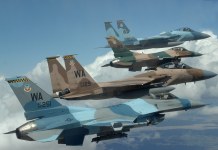What will be seen as a promising sign of enhanced cooperation between the militaries of the United States and the United Kingdom, a squadron of America’s Marine F-35B Lightning II Joint Strike Fighters completed around two months of training on the UK Royal Navy HMS Queen Elizabeth warship.
Fearing A Winter War, India Keen For A Quick Disengagement With China From Ladakh – Beijing Experts
In September of this year, the “Wake Island Avengers” of Marine Fighter Attack Squadron (VMFA) 211 and the Royal Air Force’s 617 Squadron “The Dambusters”, begun carrying out joint drills in order to operate interchangeably when the British aircraft carrier leaves on its first deployment.
Built by Britain’s Ministry of Defence, the Queen Elizabeth warship is tailor-made for the deployment of US’ F-35B variant of the stealth fighter jets which are designed for short-take off and vertical landing.
The aircraft carrier, which had set off for a short cruise from Portsmouth prior to the drills is still undergoing training ahead of next year’s maiden voyage. The drills are seen as a means to demonstrate that the two nations can fight and maintain the advanced stealth fighter jets from the warship.
Lieutenant Colonel Joseph Freshour, Commanding Officer of the VMFA-211, while speaking in an interview, provided a detailed analysis regarding how the squadrons operated combinations of aircraft while sharing parts and carrying out maintenance throughout the exercise.
“The jointness of the F-35 program really came to light and the interoperability between our two units, our tactics, the digital side of how we integrate with them tactically, everything else – how we maintain the aircraft – all really went off without a real hitch, to the point that we even were able to share parts when necessary,”
We flew mixed elements. So in our divisions at times we had a mix of U.K. and U.S. aircraft. We had U.K. pilots leading some of our U.S. wingman and vice versa.” said Freshour.
In a bid to test the interoperability and the interchangeability between the navies of the two nations, the two nation’s squadrons have put emphasis on carrying out flight operations of the warship during drills.
“On day one, we arrived and between the two squadrons put 14 aircraft and subsequently 15 aircraft when the last jet arrived from the U.K., which is nothing like they’d ever been able to practice,”
So I think that’s where the biggest learning and growing took place, was pushing the flight deck and getting the flight deck prepared for what the deployment will look like in that size and scope of aircraft.” said Freshour.
Under the drill, a total of 15 aircraft with 10 belonging to VMFA-211 and five belonging to the RAF 617, made use of the Crimson Warrior and Group Exercise to practice flight operations and carry out maintenance procedures as well.
According to the Freshour, the two squadrons could use parts of the F-35 B from a different squadron if needed.
“What was really neat is the digital side of it. So when you switch apart from their side to our side in [Autonomic Logistics Information System], that actually was quite seamless and went really well,”
Because that could be a big hindrance to the execution of that – that install of that part. So that was actually a really nice point to learn, is that we were capable of doing that and it went as planned.”
Moreover, what will be a welcome sight for the American Marines is that training in the UK has offered them an experience working in weathers they are not used to. This is according to VMFA-211 Executive Officer, Major Christopher Brandt, who said,
“I think operating in the weather that the UK has is a lot different for – our pilots are used to operating around Yuma, which is sunny, you know, 360 days out of the year,”

So I think just that flight experience – along with the experience of the deck crew, like (Freshour) was talking about on the actual ship, as well as the personnel in the tower running the tower operations – I think is a huge thing to build on for when the actual deployment comes around in the spring.”
The F-35 Lightning II is a single-seat, single-engine, all-weather stealth multirole fighters capable of performing ground attacks and air defense missions. It is considered Lockheed Martin’s ultimate crown jewel alongside the American exclusive F-22 Raptors.
The variant used by the US Marines is the F-35B short takeoff/vertical landing (STOVL) variant, which is considered to be the world’s first supersonic STOVL stealth fighter.
The advanced jets are designed to operate from austere bases and a range of air-capable ships near front-line combat zones, with the capability of taking off and landing conventionally from longer runways as well.




